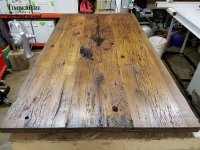I posted about this project on another thread (Other Uses for the Domino) and [member=7493]Sparktrician[/member] [member=67785]JonathanJung[/member] [member=297]Michael Kellough[/member] had some questions so I decided it was better to start a new thread. https://www.festoolownersgroup.com/...for-the-domino/msg607537/?topicseen#msg607537
We did this kitchen island several years ago. A complete description and photos of the finished project are on my website. https://www.timberfire.com/reclaimed-oak-island.html
The top is reclaimed White Oak salvaged from an Amish timber frame barn in Pennsylvania Dutch country. The boards were originally part of the threshing floor where grain was separated from straw and husks. (They were nasty and full of square nails.) We actually had to pressure wash the "organic matter" off of them which required weeks of forced air drying just to get them back to a usable moisture content. The client wanted the top VERY distressed, so we had some fun using chains, hammers, and the undulating head in the Festool HL-850 planer to add additional character.
The top was "stained" to coordinate with the floor using a custom blend of two Osmo tinted oils (Osmo Wood Wax Finish 3168 Antique Oak & 3118 Granite Gray). It was then sealed with two coats of Osmo Polyx 3011. This belongs to an interior decorator friend of mine who did the Annie Sloan finish on the base cabinets.
Anyway, here are some process photos. Please let me know if you have any questions.
Thanks!
Joe
We did this kitchen island several years ago. A complete description and photos of the finished project are on my website. https://www.timberfire.com/reclaimed-oak-island.html
The top is reclaimed White Oak salvaged from an Amish timber frame barn in Pennsylvania Dutch country. The boards were originally part of the threshing floor where grain was separated from straw and husks. (They were nasty and full of square nails.) We actually had to pressure wash the "organic matter" off of them which required weeks of forced air drying just to get them back to a usable moisture content. The client wanted the top VERY distressed, so we had some fun using chains, hammers, and the undulating head in the Festool HL-850 planer to add additional character.
The top was "stained" to coordinate with the floor using a custom blend of two Osmo tinted oils (Osmo Wood Wax Finish 3168 Antique Oak & 3118 Granite Gray). It was then sealed with two coats of Osmo Polyx 3011. This belongs to an interior decorator friend of mine who did the Annie Sloan finish on the base cabinets.
Anyway, here are some process photos. Please let me know if you have any questions.
Thanks!
Joe
Attachments
-
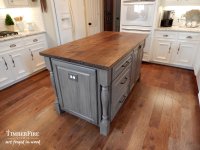 Reclaimed Island Top 02.jpg1.3 MB · Views: 454
Reclaimed Island Top 02.jpg1.3 MB · Views: 454 -
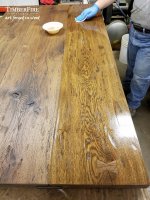 Reclaimed Oak Island Top 10.jpg627.9 KB · Views: 344
Reclaimed Oak Island Top 10.jpg627.9 KB · Views: 344 -
 Reclaimed Oak Island Top 09.jpg1.6 MB · Views: 368
Reclaimed Oak Island Top 09.jpg1.6 MB · Views: 368 -
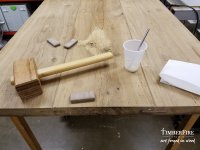 Reclaimed Oak Island Top 08.jpg1.2 MB · Views: 327
Reclaimed Oak Island Top 08.jpg1.2 MB · Views: 327 -
 Reclaimed Oak Island Top 07.jpg1.2 MB · Views: 292
Reclaimed Oak Island Top 07.jpg1.2 MB · Views: 292 -
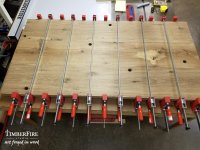 Reclaimed Oak Island Top 06.jpg1.3 MB · Views: 355
Reclaimed Oak Island Top 06.jpg1.3 MB · Views: 355 -
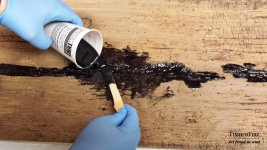 Reclaimed Oak Island Top 05.jpg982.8 KB · Views: 320
Reclaimed Oak Island Top 05.jpg982.8 KB · Views: 320 -
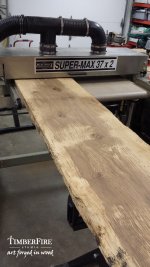 Reclaimed Oak Island Top 04.jpg924.7 KB · Views: 275
Reclaimed Oak Island Top 04.jpg924.7 KB · Views: 275 -
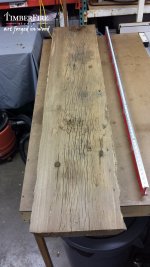 Reclaimed Oak Island Top 03.jpg1,017.7 KB · Views: 313
Reclaimed Oak Island Top 03.jpg1,017.7 KB · Views: 313 -
 Reclaimed Oak Island Top 02.jpg899.6 KB · Views: 320
Reclaimed Oak Island Top 02.jpg899.6 KB · Views: 320 -
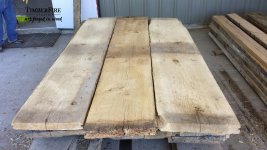 Reclaimed Oak Island Top 01.jpg1.2 MB · Views: 355
Reclaimed Oak Island Top 01.jpg1.2 MB · Views: 355

